
The Esk Valley Line is a railway line located in the north of England, covering a total distance of approximately 35 miles (56 km), running from Middlesbrough to Whitby. The line follows the course of the River Esk for much of its eastern half.
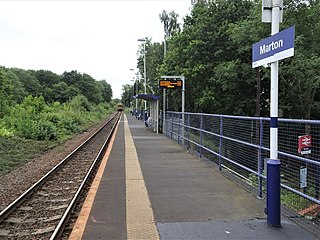
Marton is a railway station on the Esk Valley Line, which runs between Middlesbrough and Whitby via Nunthorpe. The station, situated 2 miles 79 chains (4.8 km) south-east of Middlesbrough, serves the suburbs of Marton, Middlesbrough and Ormesby, Redcar and Cleveland in North Yorkshire, England. It is owned by Network Rail and managed by Northern Trains.

Gypsy Lane is a railway station on the Esk Valley Line, which runs between Middlesbrough and Whitby via Nunthorpe. The station, situated 4 miles 3 chains (6.5 km) south-east of Middlesbrough, serves the suburb of Nunthorpe, Redcar and Cleveland in North Yorkshire, England. It is owned by Network Rail and managed by Northern Trains.
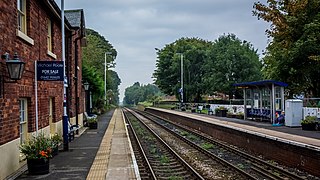
Nunthorpe is a railway station on the Esk Valley Line, which runs between Middlesbrough and Whitby via Nunthorpe. The station, situated 4 miles 48 chains (7.4 km) south-east of Middlesbrough, serves the village of Nunthorpe, Middlesbrough in North Yorkshire, England. It is owned by Network Rail and managed by Northern Trains.

Great Ayton is a railway station on the Esk Valley Line, which runs between Middlesbrough and Whitby via Nunthorpe. The station, situated 8 miles 37 chains (13.6 km) south-east of Middlesbrough, serves the village of Great Ayton, Hambleton in North Yorkshire, England. It is owned by Network Rail and managed by Northern Trains.

Kildale is a railway station on the Esk Valley Line, which runs between Middlesbrough and Whitby via Nunthorpe. The station, situated 12 miles 65 chains (20.6 km) south-east of Middlesbrough, serves the village of Kildale, Hambleton in North Yorkshire, England. It is owned by Network Rail and managed by Northern Trains.
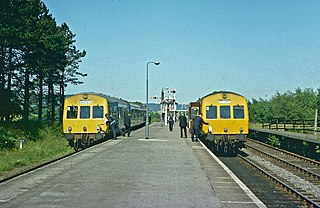
Battersby is a railway station on the Esk Valley Line, which runs between Middlesbrough and Whitby via Nunthorpe. The station, situated 11 miles 4 chains (17.8 km) south-east of Middlesbrough, serves the village of Battersby, Hambleton in North Yorkshire, England. It is owned by Network Rail and managed by Northern Trains.

Castleton Moor is a railway station on the Esk Valley Line, which runs between Middlesbrough and Whitby via Nunthorpe. The station, situated 16 miles 45 chains (26.7 km) west of Whitby, serves the village of Castleton, Scarborough in North Yorkshire, England. It is owned by Network Rail and managed by Northern Trains.
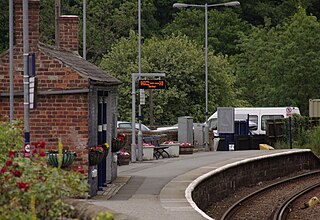
Grosmont is a railway station on the Esk Valley Line, which runs between Middlesbrough and Whitby via Nunthorpe. The station, situated 6 miles 24 chains (10.1 km) west of Whitby, serves the village of Grosmont, in the Borough of Scarborough, North Yorkshire, England. It is owned by Network Rail and managed by Northern Trains. The station is also served by heritage services operated by the North Yorkshire Moors Railway.

Nunthorpe is a village and civil parish in the Borough of Middlesbrough in North Yorkshire, England.
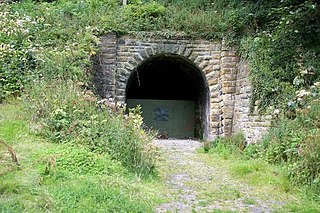
The Whitby, Redcar and Middlesbrough Union Railway (WRMU), a.k.a. the Whitby–Loftus Line, was a railway line in North Yorkshire, England, built between 1871 and 1886, running from Loftus on the Yorkshire coast to the Esk at Whitby, and connecting Middlesbrough to Whitby along the coast.
The Nunthorpe–Battersby Link was a short line connecting the Middlesbrough and Guisborough Railway and the now disused Picton-Battersby Line.

Guisborough railway station was the terminus of the Middlesbrough and Guisborough Railway. It served the town of Guisborough in North Yorkshire, England. The station was opened to goods in November 1853, and to passenger traffic on 25 February 1854. The station was closed to passengers, along with the entire Nunthorpe–Guisborough branch, on 2 March 1964, with freight being lost in August 1964.

Hutton Gate was a railway station on the Middlesbrough and Guisborough Railway. It was opened on 25 February 1854 and closed along with the entire Nunthorpe-Guisborough branch on 2 March 1964. The station stands on Hutton Lane, just east of its junction with The Avenue.

Pinchinthorpe railway station was a railway station on the Middlesbrough and Guisborough Railway (M&GR). It was opened on 25 February 1854 and closed in 1951, thirteen years before the rest of the Nunthorpe–Guisborough branch. It served the village of Pinchinthorpe in North Yorkshire, England, a few miles west of Guisborough railway station.

The Picton–Battersby line was a railway line running from Picton, North Yorkshire, England, on what is now the Northallerton–Eaglescliffe line, to Battersby on what is now the Esk Valley line.
The Cleveland Railway was a railway line in north-east England running from Normanby Jetty on the River Tees, near Middlesbrough, via Normanby and then via Guisborough through the Eston Hills, to Loftus in East Cleveland. It carried minerals from numerous iron ore mines along its route to the River Tees for shipment to Tyneside and elsewhere. The line was jointly proposed by the West Hartlepool Harbour and Railway (WHH&R), who provided half its capital, together with various landowners. The WHH&R lay on the north bank of the Tees, to which it had a cross-river connection via a jetty at Normanby.
The Rosedale Railway was a 19.5-mile (31.4 km) goods-only railway line running from Battersby Junction via Ingleby Incline, across the heights of the North York Moors in North Yorkshire, England to reach iron ore deposits in the remote hills of the Rosedale valley. It opened to traffic as a narrow gauge railway to Ingleby Incline top in 1858, converted to standard gauge and opened to Rosedale West in 1861, and closed completely in 1929. Apart from Ingleby Incline, no major engineering works were constructed, and as such, particularly the east branch, the railway followed the contours of the surrounding hillside. The former trackbeds of the railway are in use by walkers and cyclists.

Boosbeck railway station was a railway station serving the village of Boosbeck in the ceremonial county of the North Riding of Yorkshire in England. The station was opened in 1878 and closed to passengers in 1960 with freight services being stopped in 1964.

Hutton Village is a settlement in the Hutton Lowcross area of Guisborough in North Yorkshire, England. Whilst the area itself is mentioned in the Domesday Book, the village was built largely due to the development of the ironstone industry in the Cleveland Hills. The name Hutton Lowcross referred to the township in the area, whereas the settlement is now known as Hutton Village. The village is set in a narrow dale that carries Hutton Beck northwards towards Guisborough.




















